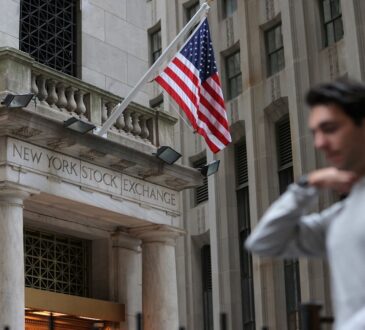
While the market has seemingly begun to broaden beyond a handful of the largest stocks, the so-called Magnificent 7 has continued to outperform year-to-date after massive returns in 2023. The Magnificent 7 consists of MicrosoftMSFT (MSFT), Meta PlatformsFB (META), Amazon.com (AMZN), AppleAAPL (AAPL), NVIDIANVDADIA (NVDA), Alphabet (GOOGL), and TeslaTSLA (TSLA). Does this mean the stock market will fall sharply when those leaders inevitably waver?
Stock Returns
Glenview Trust, Bloomberg
In 2023, the mega-capitalization stocks outperformed the average S&P 500 company by the widest margin since the start of the tech bubble in the late 1990s.
Mega Cap Outperformance
Glenview Trust, Bloomberg
In addition, the ten largest companies now make up almost 34% of the total market capitalization of the S&P 500. While this may raise concerns, market concentration was higher than current levels in the past and, by some measures, was higher from 1926 through the 1960s.
Top 10: Weight In The S&P 500
Glenview Trust, Bloomberg
Despite the Magnificent 7 being a relatively new creation, it is similar to the ten largest stocks since all companies except Tesla (TSLA) are also in the top ten.
Magnificent 7: Weight In The S&P 500
Glenview Trust, Bloomberg
Looking at the calendar years with positive returns in which the top ten stocks contributed the most to the S&P 500 returns, 2023 ranks second highest since 1991. While there are notable years (2007 and 2021) where the S&P 500 had sizable losses in the following year, overall, the S&P was still higher 60% of the time with a median return of 6.6%.
Momentum strategies buy the stocks that have performed the best over a past period, usually 12 months, and hold them, expecting outperformance to continue. Then, these strategies rebalance on a consistent cadence to buy the next batch of top-performing stocks. As you can imagine, momentum strategies have done quite well in 2024, as many of the same stocks, like the Magnificent 7, have continued to outperform. Again, there is no sure thing that these stocks needed to do poorly in the following year, as momentum stocks had positive returns 60% of the time, with a median return of 7.4%.
S&P 500 Top 10 Contribution In Positive Years
Glenview Trust, Strategas, Bloomberg
As noted previously, in 2023, the S&P 500 outperformed the average stock, as measured by the equal-weighted S&P 500, by the second-largest margin since 1991. Again, the evidence indicates no inevitable decline in the S&P 500 in the next year. The S&P 500 and momentum strategies have historically been higher 80% of the time in the following year, with median returns of 24.7% and 21.9%, respectively.
It should be noted that both the tech bubble and the Global Financial Crisis (GFC) had multi-year positive return years leading up to the eventual judgment day. The current excitement about technology and artificial intelligence (AI) is not analogous to the tech bubble because the current crop of large technology companies is incredibly profitable. The price paid for these companies will impact future expected returns, but a widespread bust seems unlikely at this point.
S&P 500 Performance Versus The Average Stock
Glenview Trust, Bloomberg
The next crucial economic data for markets is the monthly jobs report on Friday. There remains no indication from weekly unemployment claims that the labor market is softening enough to lead to a recession. Still, the payrolls report will be closely watched for implications regarding the economy, wage pressures, and inflation.
Initial Jobless Claims
Glenview Trust, Bloomberg
Federal Reserve Chair Powell’s rate-cut-friendly comments after the Fed meeting sent market odds to an 85% chance of a Fed easing in June, up from 60% in the prior week. Fed Governor Waller threw some cold water on the euphoria on Wednesday, and the odds of a June cut currently sit at around 66%. The probabilities strongly favor a June or July start to the Federal Reserve’s short-term interest rate cuts. Fed Fund futures are looking for three cuts of 25 basis points (0.25%) each in 2024.
Probability Of Fed Rate Cut
Glenview Trust, Bloomberg
While the history of performance following a concentrated market holds doesn’t argue for caution, excessively positive investor sentiment might be a better reason for caution. Indeed, stocks can continue to power higher, but investor optimism has reached a level that typically leads to at least a pause at some point.
Investor Sentiment
Glenview Trust, Bloomberg
Despite some understandable fears, the robust performance of stocks based primarily on a small number of large companies has historically not always led to a bad outcome. Indeed, one could argue that we are witnessing the broadening of performance this year. More concern should be paid to the lofty expectations of a soft landing for the economy and strong earnings growth baked into stock valuations. While these optimistic outcomes seem likely to come to pass, stocks have less room for error after the S&P 500’s 25% rally since the end of October. Stock market timing is a fool’s errand, but ensuring your portfolio matches your risk tolerance, and some caution on the margins makes sense here. It will be quiet on the earnings front in the coming week, but the first quarter of the earnings season begins the week after. The monthly jobs report on Friday will be closely watched since it adds another puzzle piece to the outlook for Fed rate cuts.
Follow me on Twitter or LinkedIn. Check out my website.
Disclosure: Glenview Trust currently has holdings of Microsoft (MSFT), Meta Platforms (META), Amazon.com (AMZN), Apple (AAPL), NVIDIA (NVDA), and Alphabet (GOOGL) within its recommended investment strategies.

